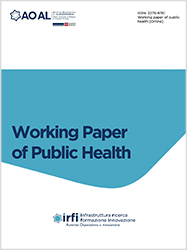Assessment of hand hygiene procedures during the pre- and post-pandemic period: a pre-post study

Accepted: 3 April 2023
All claims expressed in this article are solely those of the authors and do not necessarily represent those of their affiliated organizations, or those of the publisher, the editors and the reviewers. Any product that may be evaluated in this article or claim that may be made by its manufacturer is not guaranteed or endorsed by the publisher.
Background: hospital infections affect about 6% of hospitalised patients in Europe; the hands of healthcare workers, who are front-line staff and frequently exposed to infected patients and contaminated surfaces, are the primary source of microbial transmission. Thus, hand washing procedures are essential to lowering the risk of occupational exposure to infectious diseases, hospital-acquired infections, and micro-organism cross-transmission. The aim of this study was to see if the COVID-19 pandemic had any effect on hand-washing adherence rates by conducting a pre-post pandemic wave study from the pre-pandemic year 2019 to the post-pandemic years 2020/2022. Methods: an observational, retrospective, single-center study. The study considers hand hygiene observations of all personnel employed as healthcare staff from 2019, during the pre-pandemic period, and in the three years following the outbreak from 2020 to 2022, during the post-pandemic period and a specific study on hydroalcoholic gel consumption. The study will use the “Hand Hygiene Observation Form”, to evaluate adherence to best practices. Conclusions: a dedicated facility that promotes the application of the recommended hand hygiene behavior and ongoing improvement and training initiatives, is crucial to ensure and improve the compliance of all healthcare workers.
Suetens C, Latour K, Kärki T, et al. Prevalence of healthcare-associated infections, estimated incidence and composite antimicrobial resistance index in acute care hospitals and long-term care facilities: results from two European point prevalence surveys, 2016 to 2017. Euro Surveill Bull Eur Sur Mal Transm Eur Commun Dis Bull. 2018;23:1800516. DOI: https://doi.org/10.2807/1560-7917.ES.2018.23.46.1800516
Koscova J, Hurnikova Z, Pistl J. Degree of Bacterial Contamination of Mobile Phone and Computer Keyboard Surfaces and Efficacy of Disinfection with Chlorhexidine Digluconate and Triclosan to Its Reduction. Int J Environ Res Public Health. 2018;15:2238. DOI: https://doi.org/10.3390/ijerph15102238
Gammon J, Hunt J. The neglected element of hand hygiene - significance of hand drying, efficiency of different methods and clinical implication: A review. J Infect Prev. 2019;20:66–74. DOI: https://doi.org/10.1177/1757177418815549
Gold NA, Mirza TM, Avva U. Alcohol Sanitizer. StatPearls. Available from: http://www.ncbi.nlm.nih.gov/books/NBK513254/
Toney-Butler TJ, Gasner A, Carver N. Hand Hygiene. StatPearls. Available from: http://www.ncbi.nlm.nih.gov/books/NBK470254/
World Health Organization, WHO Patient Safety. Hand hygiene technical reference manual: to be used by health-care workers, trainers and observers of hand hygiene practices. 2009. Available from: https://apps.who.int/iris/handle/10665/44196
Lambe KA, Lydon S, Madden C, et al. Hand Hygiene Compliance in the ICU: A Systematic Review. Crit Care Med. 2019;47:1251. DOI: https://doi.org/10.1097/CCM.0000000000003868
Le CD, Lehman EB, Nguyen TH, Craig TJ. Hand Hygiene Compliance Study at a Large Central Hospital in Vietnam. Int J Environ Res Public Health. 2019;16:607. DOI: https://doi.org/10.3390/ijerph16040607
Roshan R, Feroz AS, Rafique Z, Virani N. Rigorous Hand Hygiene Practices Among Health Care Workers Reduce Hospital-Associated Infections During the COVID-19 Pandemic. J Prim Care Community Health. 2020;11:2150132720943331. DOI: https://doi.org/10.1177/2150132720943331
Israel S, Harpaz K, Radvogin E, et al. Dramatically improved hand hygiene performance rates at time of coronavirus pandemic. Clin Microbiol Infect Off Publ Eur Soc Clin Microbiol Infect Dis. 2020;26:1566–8. DOI: https://doi.org/10.1016/j.cmi.2020.06.002
Labarca J, Zambrano A, Niklitschek S, et al. H1N1 pandemic influenza impact on hand hygiene and specific precautions compliance among healthcare workers. J Hosp Infect. 2011;79:177–9. DOI: https://doi.org/10.1016/j.jhin.2011.06.003
WHO Guidelines on Hand Hygiene in Health Care: First Global Patient Safety Challenge Clean Care Is Safer Care. Geneva: World Health Organization; 2009. (WHO Guidelines Approved by the Guidelines Review Committee). Available from: http://www.ncbi.nlm.nih.gov/books/NBK144013/
Yoo E, Ursua L, Clark R, et al. The effect of incorporating covert observation into established overt observation-based hand hygiene promotion programs. Am J Infect Control. 2019;47:482–6 DOI: https://doi.org/10.1016/j.ajic.2018.11.002
Furmenti MF, Zotti M. L’igiene delle mani nel nostro Paese: i dati del PPS”. 2019. Available from: https://www.salute.gov.it/imgs/C_17_EventiStampa_550_intervisteRelatori_itemInterviste_15_fileAllegatoIntervista.pdf
Copyright (c) 2023 Paola Toselli, Roberta Di Matteo, Serena Penpa, Tatiana Bolgeo, Denise Gatti, Elisabeth Marino, Barbara Montanari, Marco Ricci, Cesare Bolla, Antonio Maconi

This work is licensed under a Creative Commons Attribution-NonCommercial 4.0 International License.
PAGEPress has chosen to apply the Creative Commons Attribution NonCommercial 4.0 International License (CC BY-NC 4.0) to all manuscripts to be published.

 https://doi.org/10.4081/wpph.2023.9718
https://doi.org/10.4081/wpph.2023.9718




